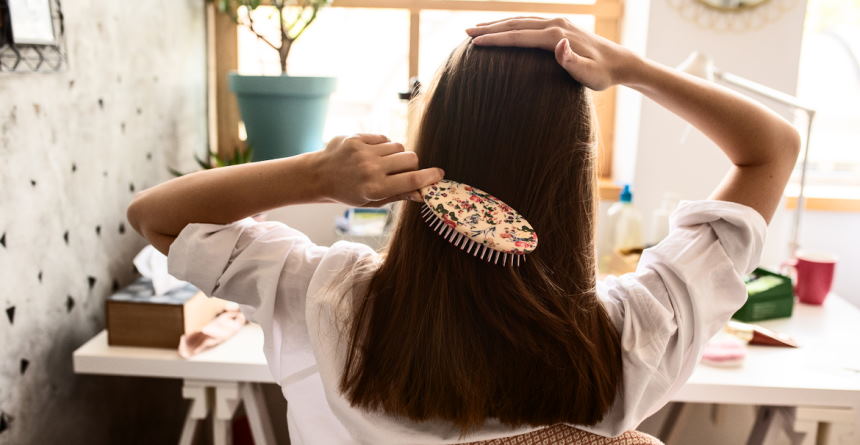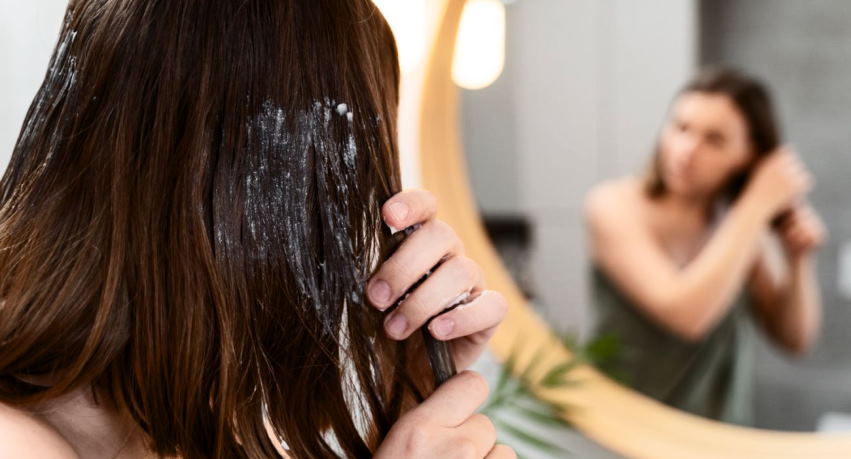
Static hair can be a nuisance, regardless of your hair type or condition. Even the healthiest type of locks are vulnerable to this pesky problem—the result of moisture-filled air and other environmental factors like humidity and air pollution that leave your tresses tangled, limp, and electrically charged. Fortunately, there’s hope for dealing with static hair. In this article, we will take you through what static hair is exactly (and why it occurs) and provide an essential guide to controlling staticky tresses with simple tips and tricks so that you can say goodbye to puffy locks once and for all!

Reasons why your hair might be static
- Dry air – Low humidity levels can cause hair to become charged with static electricity, leading to flyaways and frizz.
- Synthetic materials – Wearing hats, scarves, and other clothing made from synthetic materials can increase the amount of static in your hair.
- Overuse of heated styling tools – Blow dryers, curling wands, and flat irons can make your hair more prone to static electricity.
- Rubbing or brushing your hair when it’s dry – Using a brush or comb when your hair is dry will create friction which generates an electrical charge that causes static in your hair strands.
- Unbalanced pH levels – When the pH balance of your hair is off, it can cause it to become too dry and lead to static.
- Weather conditions- Cold or windy weather can create a lot of static electricity in your hair due to the low humidity level in the air.
- Hair products- Products such as hairspray, mousse, and wax can all add to the problem of static in your hair if they are overused.
- Shampoos and Conditioners – If your shampoo and conditioner don’t have enough moisturizers, it can cause your hair to dry and more prone to static electricity.
- Poor-quality hairbrush- A brush with poor-quality bristles can cause static in your hair, so make sure you use a brush specifically designed for your hair type.
- Overconditioning- Applying too much conditioner to your hair can leave it feeling oily and heavy, increasing the amount of static electricity in it.
By understanding what might be causing static in your hair, you can take steps to minimize it and keep flyaways at bay. For example, try using anti-static products such as leave-in conditioners or sprays, avoiding heat-styling tools as much as possible, and keeping the air around you more humidified with a humidifier. With the right precautions and products, you can reduce the amount of static in your hair and keep it looking sleek and smooth.

Ways to prevent static hair
- Use a moisturizing conditioner: Moisturizing your hair helps prevent static electricity by adding moisture back into the hair and scalp. Look for a conditioner that contains natural oils like coconut, jojoba, and olive oil.
- Comb your hair with a wide-toothed comb: Towel drying is less effective than air drying when preventing static hair. So try to avoid towel drying whenever possible and use a wide-toothed comb instead. This will help distribute the natural oils from root to tip while also helping reduce static buildup in the process.
- Avoid overwashing: Overwashing your hair can strip away its natural oils, leading to dry, brittle strands that are more prone to static. If you have oily hair, try washing it every other day to balance oil production and prevent static electricity from forming on your locks.
- Use a silk or satin pillowcase: The fibers in these fabrics reduce friction between them and your hair as you sleep, reducing static buildup. Silk and satin also maintain moisture levels around the scalp, helping keep static at bay while keeping your locks looking shiny and healthy.
- Apply a serum or anti-static spray: To help tame flyaways caused by static, use a light serum or an anti-static spray on damp hair before styling. These products form a protective barrier around each strand of hair which helps reduce the likelihood of static cling.
- Invest in a humidifier: Using a humidifier can be beneficial if you live in an area with low humidity. It helps to add moisture back into the air, preventing your hair from drying out and becoming statically charged. This is especially helpful during the winter months when temperature drops and humidity levels are lower.
- Avoid plastic combs and brushes: Plastic combs and brushes create friction against your strands when you use them, leading to split ends and static electricity buildup. Try switching to metal or wooden combs instead, as these materials don’t create as much friction against your locks.
- Wear natural fibers: Wearing clothes made of synthetic fabrics like polyester or nylon can increase static electricity in your hair. On the other hand, cotton, silk, and wool are all great fabrics to wear as they don’t create as much friction against your hair.
- Use fabric softener: Adding a capful of fabric softener to the rinse cycle when you do your laundry helps reduce static buildup on clothes which can then be transferred onto your hair. This is an especially helpful tip if you live in an area with low humidity levels.
- Reduce heat styling: Heat styling products like blow dryers and straighteners cause damage to the hair shaft’s cuticle layer, leading to increased static electricity levels. Try limiting heat styling whenever possible and opt for air drying instead for the best results.
By following the above tips, you should be able to keep your hair looking healthy and static-free all year long. Regularly moisturizing, using a humidifier, and avoiding excessive heat styling is key for preventing static electricity buildup in your locks. You can keep your hair looking and feeling its best by taking care of it properly!

